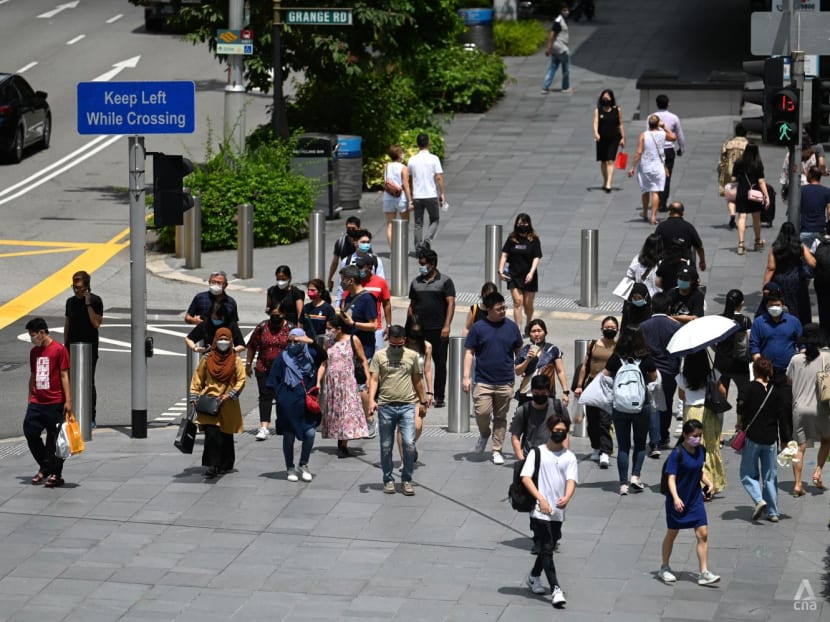Explainer: How does MAS monetary policy work and can it help tame inflation?

People are seen walking along Orchard Road in Singapore on Mar 29, 2022. (File photo: CNA/Marcus Mark Ramos)
SINGAPORE: To rein in inflation - which is expected to keep rising - the Monetary Authority of Singapore (MAS) further tightened its monetary policy in a two-in-one move on Thursday (Apr 14).
This marks the third tightening move – and the most aggressive – made by the central bank in six months.
While policy tightening was widely expected this time amid rising inflation, the two-in-one move was a surprise for some observers.
The MAS first tightened policy in October last year when it raised the slope of its exchange-rate based policy band to allow the Singapore dollar to appreciate at a slightly faster pace. It then followed up with another steepening of the slope in January, surprising markets with an inter-meeting adjustment.
On Thursday as it released its half-yearly policy statement, the Singapore central bank said it would raise the slope of appreciation “slightly” yet again, while re-centering the mid-point of the policy band “at the prevailing level”.
Doing so will help to “slow the inflation momentum and help ensure medium-term price stability”, it noted.
There was no change to the band’s width – the third lever in MAS’ policy toolkit which is largely reserved for periods of increased uncertainties or volatility.
The last time the central bank deployed these two levers at the same time to tighten monetary policy was in April 2010, when the economic recovery from the global financial crisis had picked up pace.
“(The move) surprised markets a little since it’s the first time that MAS has used both of these tools together to tighten policy in the past 12 years,” said Ms Clara Cheong, global market strategist at JP Morgan Asset Management in Singapore.
Q: How does MAS’ monetary policy work?
The MAS has a unique approach to monetary policy.
Unlike most central banks that manage monetary policy through the interest rate, it uses the exchange rate as its main policy tool because Singapore is an open economy that depends heavily on trade.
This refers to the Sing dollar nominal effective exchange rate (S$NEER) – the exchange rate of the Singapore dollar managed against a trade-weighted basket of currencies from Singapore’s major trading partners.
MAS allows the S$NEER to float within an unspecified band. Should it go out of this band, it steps in by buying or selling Singapore dollars.
The central bank also changes the slope, width and mid-point of the band when it wants to adjust the pace of appreciation or depreciation of the local currency based on assessed risks to Singapore’s growth and inflation.
The three policy levers of MAS
1. The slope
This is probably the most common tool used by the MAS to adjust the band.
Simply put, the slope determines the rate at which the Sing dollar appreciates. If the slope is reduced, this means the local currency will be allowed to strengthen at a slower pace. It strengthens at a faster pace when the slope is increased.
2. The mid-point
This is a tool generally reserved for “drastic” situations, such as recessions, when the outlook for growth and inflation sees an abrupt and rapid change.
Compared to tweaks in the slope, an adjustment in the mid-point either upwards or downwards is likely to yield a quicker and bigger impact on the currency, economists have said.
3. The width
This controls how far the Sing dollar can fluctuate. This means the wider the band, the more volatile the currency can be.
It is typically reserved for periods of increased uncertainties or volatility.
For instance, the band was widened in October 2001 after the Sep 11 terrorist attacks in the United States led to extreme volatility in the financial markets. More recently in October 2010, the width was also widened slightly “in view of the volatility across international financial markets”.
Q: Why is there a need for the monetary policy to be tightened a third time?
This is due to inflation, which has been heating up on the back of a “perfect storm” of factors such as pandemic-induced global supply chain disruptions and Russia’s invasion of Ukraine that has worsened an ongoing energy crisis.
A moderate amount of inflation is generally seen as a sign of a healthy economy. This is because as the economy grows, demand for goods and services typically increases which in turn pushes prices higher.
But too high an inflation will dilute consumers’ purchasing power and erode corporate margins, while stirring instabilities in the economy.
Latest data showed Singapore’s headline inflation rose at 4.3 per cent in February, the fastest rate in nine years. Core inflation, which strips out private road transport and accommodation costs, eased to 2.2 per cent in February but that is set to be temporary.
MAS on Thursday warned that inflation will increase “more than previously anticipated” in the quarters ahead, due to “sharply higher” global commodity prices and renewed supply chain snarls brought about by the Ukraine war and the COVID-19 pandemic.
Domestically, a tight labour market will add upward pressure on inflation.
This was why the MAS upgraded its inflation forecasts for 2022 again. It now expects core inflation to come in at 2.5 to 3.5 per cent and overall inflation to be within the range of 4.5 to 5.5 per cent this year.
But Singapore is not alone in tightening policy to fight rising price pressures.
South Korea’s central bank also tightened policy in an unexpected move on Thursday morning, while global central banks, led by the US Federal Reserve, have begun raising interest rates earlier this year.
Q: How will the latest policy tightening help to tame inflation?
In general by tightening monetary policy, the MAS is effectively allowing the Sing dollar to appreciate.
This makes imports cheaper – an important move given how Singapore buys almost everything it consumes from abroad – and in turn helps to put a lid on the rise in prices of goods and services here.
The aggressive tightening, particularly with the re-centering of the band, will give a jolt to the Sing dollar, analysts said.
MUFG Bank’s senior currency analyst Jeff Ng estimates that the latest steepening in the slope means that the S$NEER is now allowed to appreciate at a rate of 1.5 per cent per annum, while the policy band has been re-centered higher by 1.9 to 2 per cent.
Combined, these can give the S$NEER a boost of “a maximum of 3 to 4 per cent” in the coming months, he said, adding that the Sing dollar will have room “to strengthen more decisively” and help curb the momentum of imported inflation for a wide range of items, from food to energy.
In tandem, Mr Ng has revised his year-end target for the Sing dollar to 1.31 per US dollar, from 1.33 previously.
He is not the only one.
“With the S$NEER set to increase by around 1.5 per cent a year, the Sing dollar should strengthen sharply against other Asian currencies, as well as edge up against a strong US dollar,” said Mr Alex Holmes from Capital Economics, who has a forecast for the Sing dollar to end the year at 1.35 against the greenback by end-2022.
The Sing dollar was last seen trading at 1.3527 against the US dollar on Thursday, up 0.7 per cent.
Q: What does this mean for you?
While the central bank’s move will help to rein in price increases, economists said the impact may not be felt until a few months later.
This, as businesses would have negotiated the prices for their supplies in deals or contracts inked months ago. Time will be needed for the effects of monetary policy tweaks to flow through the supply chain – from suppliers, wholesalers to retailers – before reaching end-consumers, analysts said.
On the other hand, a stronger Sing dollar against the currencies of other countries will suggest more favourable exchange rates for those heading overseas.
Q: What’s next?
Economists are already looking ahead to the MAS’ next scheduled policy meeting in October, with some expecting more policy tightening to come.
The central bank’s “tightening window is not completely closed yet”, said OCBC Bank’s chief economist and head of treasury research and strategy Selena Ling, pointing to a line in the policy statement on how the MAS is staying “vigilant to developments in the external environment and their impact on the Singapore economy”.
The MAS also mentioned how underlying inflationary pressures remain a risk over the medium term, indicating that “the light of the end of the inflation tunnel is not yet visible”, said Ms Ling.
As such, externally-driven inflation – namely commodity and food prices which will push up electricity and gas, fuel and non-cooked food prices – as well as domestic cost pressures such as labour and rents will be key factors to watch over the next six months, the OCBC economist added.
Barclays Bank economist Brian Tan also expects the MAS to steepen the slope of its policy band again in October, albeit “at a more measured pace of 50 basis points”.
“The decision to again raise the slope only ‘slightly’ today suggests the MAS remains mainly focused on demand-pull price pressures on this front, which are likely to stay elevated due to tight labour market conditions, but unlikely to rise to levels that favour a more aggressive pace of adjustments,” he wrote in a note.
Maybank economists Chua Hak Bin and Lee Ju Ye said they see the MAS maintaining its current tighter stance and steeper slope at the next policy meeting, “unless inflation surprises on the upside to such an extent, warranting yet another material change” to the central bank’s inflation forecasts.










